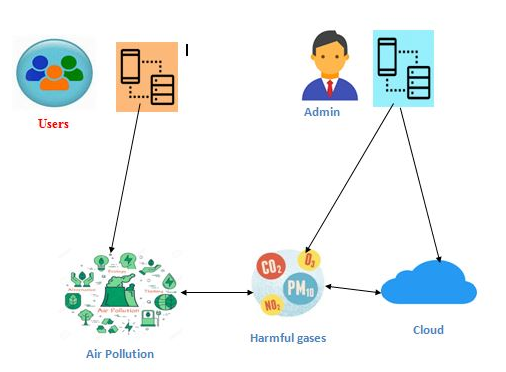Air Pollution Detection Using ML.
Objective
Air pollution causes damage to crops, animals, forests, and bodies of water. It also contributes to the depletion of the ozone layer, which protects the Earth from the sun's UV rays. Another negative effect of air pollution is the formation of acid rain, which harms trees, soils, rivers, and wildlife.
Abstract
In the coming days air pollution Pose a threat to biological survival. Satellite observation of air pollution allows for wider geographical scope, and in doing so can facilitate studies of air pollution's effects on natural capital and ecosystem resilience. Many air pollution-related aspects of the sustainability of development in human systems are not being given their due attention. The regulation of air pollutant levels is rapidly increasing and its one of the most important tasks for the governments of developing countries, especially India.
It is important that
people know what the level of pollution in their surroundings is and takes a
step towards fighting against it. The meteorological and traffic factors, burning of
fossil fuels, industrial parameters such as power plant emissions play
significant roles in air pollution. Among all the particulate matter (PM) that determine
the quality of the air. When its level is high in the air, it causes
serious issues on people’s health. Hence, controlling it by constantly keeping
a check on its level in the air is important
NOTE: Without the concern of our team, please don't submit to the college. This Abstract varies based on student requirements.
Block Diagram

Specifications
SOFTWARE SPECIFICATIONS
- Operating System: Windows and Android
- SDK IDE: Android Studio 3.3
- Virtual Emulator: Nexus Pixel 2
- Programming Language: Java
- Front End: Xml
- Server scripting Language: PHP
- Database: MySQL
HARDWARE SPECIFICATIONS
- CPU type: Intel i7
- Ram size: 16 GB
- Hard disk capacity : 1TB
- Monitor type: 15 Inch color monitor
- Keyboard type: Internet keyboard
- Mobile: Android
Learning Outcomes
- How to SPM value.
- How to predict the pollution.
- Real time application scenarios.
- Creating the model.
- How model gets trained.
- How ML can work and real time applications.
- Android architecture.
- Basic about java.
- Basic about MySQL.
- Knowledge about server side programming.
- Difference between client side and server side programming language.
- Knowledge about server.
- Knowledge about database and queries.
- Knowledge about Volley API.
- How to communicate with API.
- How API Communicate with Server.
- What are Packages and dependencies regarding the app?
- What are various versions of android app and android operating system.
- About Android studio.
- Client side validation.
- Server side validation.
- Difference between client side validations.
- Different Debugging Techniques.
- Deployment of app.
- About play store deployment.
- What is manifest?
- About XML.
- Widgets in android.
- Views in android.
- Layouts in android.
- How to design the user Interface.
- Project Development Skills:
- Problem analyzing skills.
- Problem solving skills.
- Creativity and imaginary skills.
- Programming skills.
- Deployment.
- Testing skills.
- Debugging skills.
- Project presentation skills.
- Thesis writing skills.





 Paper Publishing
Paper Publishing
